EDITOR’S NOTE: Traveleater Joanna Kozuch – a Polish food expert from Wroclaw – shares with us 25 traditional dishes you need to try on your next trip to Poland.
So you’re planning a trip to Poland and thinking to pack some snacks just in case? No need to do that. We will help you to dive into traditional Polish food and make the right choices once you get there. This country in the heart of Europe has so much to offer when it comes to traditional food, that you’ll rebook your return ticket just to taste some more.
Let’s be honest – it’s nice to admire cities, meet the locals, and get to know the history of the country a bit better, but it’s all for nothing if you don’t try the local cuisine. Polish food will make your memories have a taste. And they will be delicious.
POLISH FOOD QUICK LINKS
If you’re visiting Poland and want to really learn about Polish cuisine, then you may be interested in taking a cooking class.
TOURS & OTHER SERVICES
- Cooking Classes: Cooking Classes in Poland
- eSIM: Poland eSIM
Save This on Pinterest!
No time to read this article on traditional Polish food? Click on the save button and pin it for later!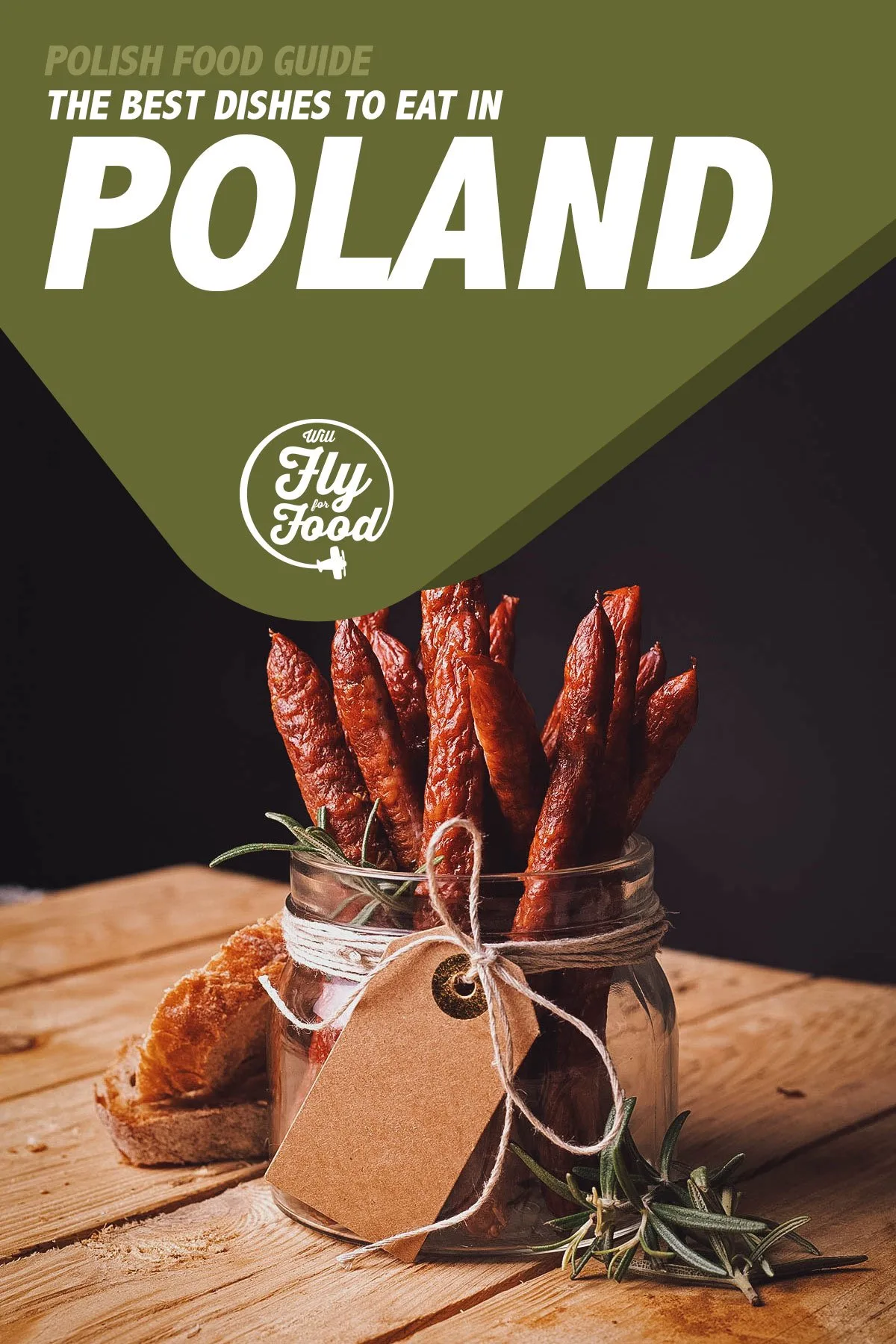
Photo by JacZia
WHAT IS TRADITIONAL POLISH CUISINE?
Thanks to its long history, and inspirations from other regional cuisines, Polish food has a special place in the hearts of many foodies worldwide. Growing and evolving over the centuries, it became truly eclectic, strongly formed, and at the same time creative.
Many traditional dishes originated in difficult times, with access to limited food resources. Through the years, they became ever-present on Polish tables. They expanded in range, gained the recognition of many palates, and evolved with new ingredients and ways of serving.
Polish cuisine has always been rich in meat, vegetables, mushrooms, spices, and herbs – all gifts of the Polish climate and land. Heavy winters created the necessity for rich and fatty dishes and helped to invent pickled and fermented products.
Another important feature is patience. Until today, some main dishes for special occasions – like Christmas Eve – take days to prepare. This method of food preparation made food part of the celebration.
Today, we can see how Polish cuisine is transforming, navigating between tradition and new trends. Relying so heavily on meat, it tries to create more and more vegetarian options. By finding forgotten dishes and creating new ones, it adapts to constantly changing reality while sticking to its own rules.
MUST-TRY POLISH FOODS
This article on traditional Polish foods has been organized by category to make it easier to go through. Click on a link to jump to any section of the guide.
STARTERS / SIDES
1. Oscypek
This hard, smoked sheep’s cheese can be tasted in the highland cultural region of southern Poland, in the Tatra Mountain range (for example, in Podhale). It’s where it was originally made.
Oscypek is worth appreciating not just for its unique taste, but also for its visual characteristics, most notably its beautifully decorated edges. It’s often served with cranberry jam, whose sweetness pairs perfectly with the cheese’s salty and strong flavors.
Interestingly, real oscypek is produced only from Spring until the end of December. It takes milk from as many as thirty sheep to produce one oscypek!
Since 2008, oscypek has been registered under the European Union Protected Designation of Origin, which helps to preserve the integrity of food-related products. So if you want to try real certified oscypek, then you need to go to Podhale to enjoy its unique taste.
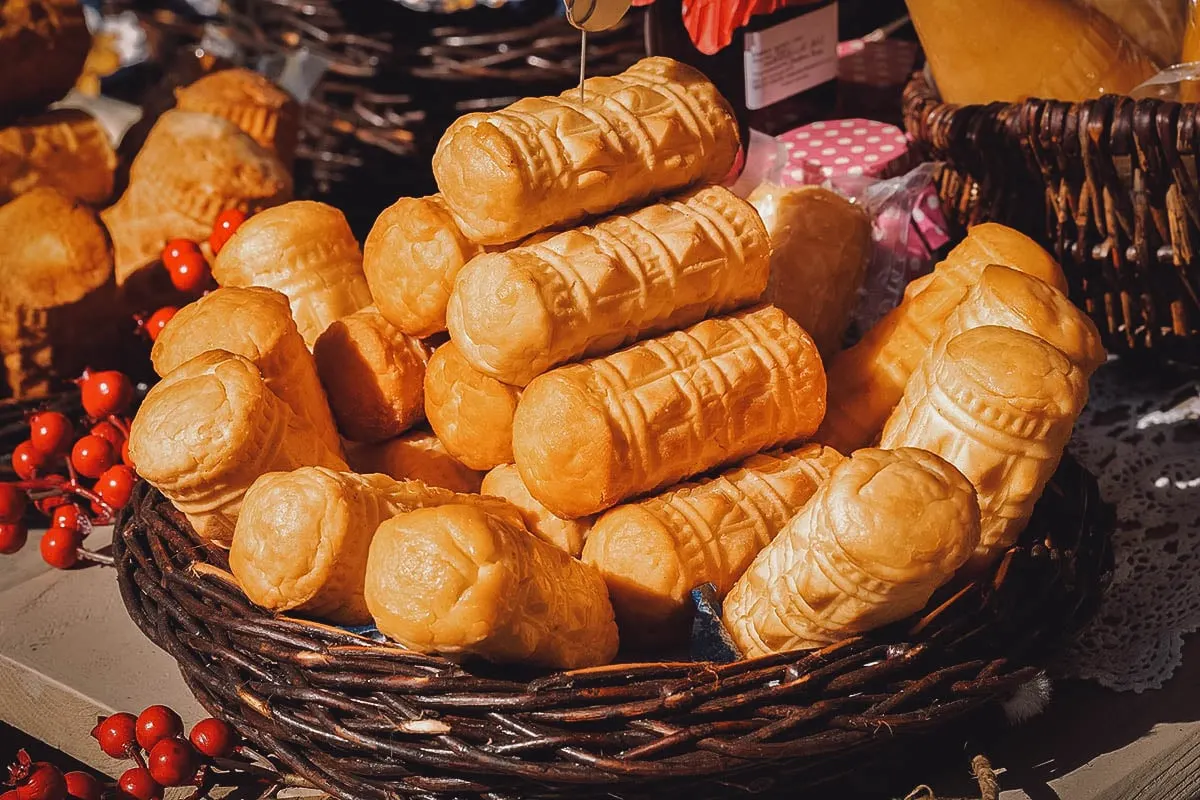
Photo by tomeqs
2. Placki Ziemniaczane (Polish Potato Pancakes)
Who doesn’t like potatoes? In Poland, you can taste this root vegetable in countless forms. One of them is placki ziemniaczane, which is the Polish version of potato pancakes.
Back in the 17th century, pancakes made from grated potatoes were a basic dish in monasteries, and it’s from one of these monasteries where the oldest recipe was developed. In the small Polish village of Stoczek where the recipe was written, placki were made with one onion, two eggs, and a spoonful of wheat flour per kilo of potatoes. Once made, they were eaten with salt and pepper.
Nowadays, you can serve authentic Polish potato pancakes in different ways. But at traditional polish homes, the most common way is to eat them with sour cream (and here comes the conflict between people who put sugar on top and those who would never do such a thing!), mushroom sauce, or goulash.
Versions made with goulash are referred to as placek po węgiersku, which means “Hungarian pancake”.
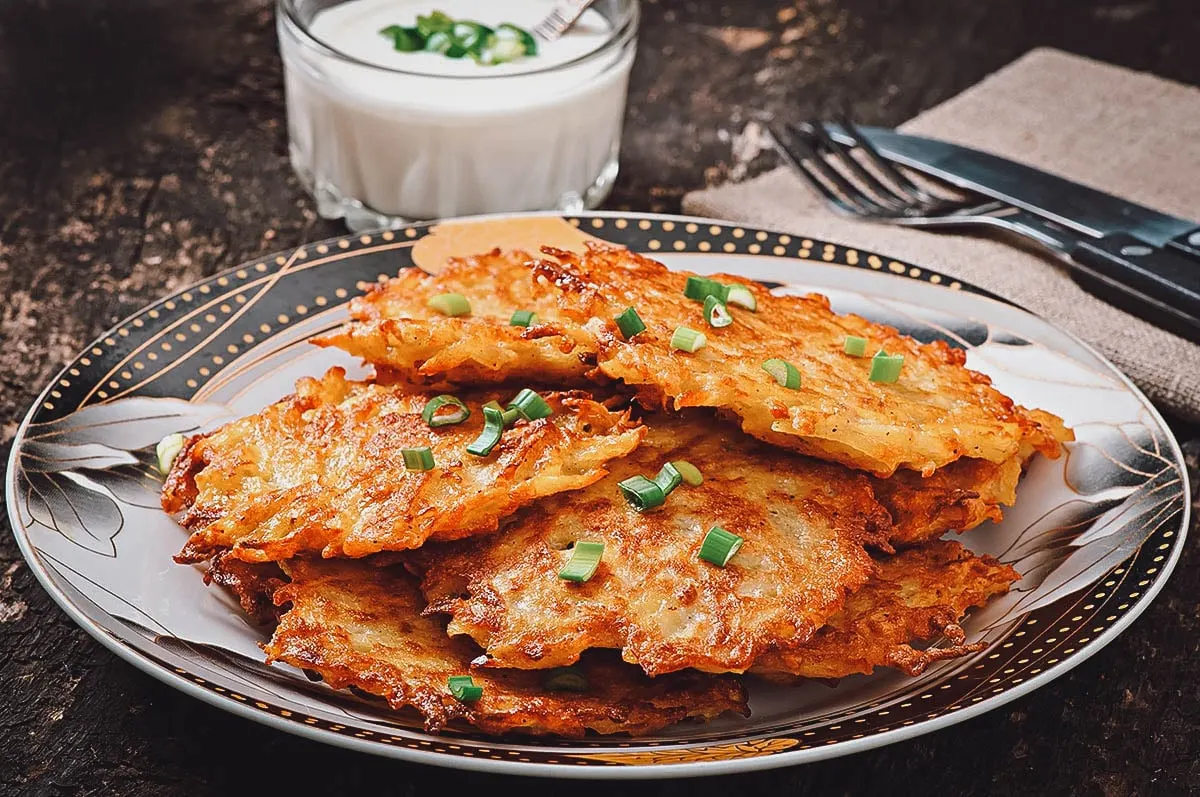
Photo by Timolina
3. Krokiety
Do you think there’s nothing better than a classic crepe? Well, that’s where the krokiet comes in.
The Polish version of croquettes, krokiety consist of breaded crepe-like pancakes stuffed with a savory filling and then fried on a pan. They’re typically filled with minced meat, mushrooms, cheese, fermented cabbage, or some combination of those ingredients.
During the Christmas season, krokiety are served with hot borscht. Krokiet and borscht are a match made in heaven. When you try this pairing, you may just consider moving to Poland!
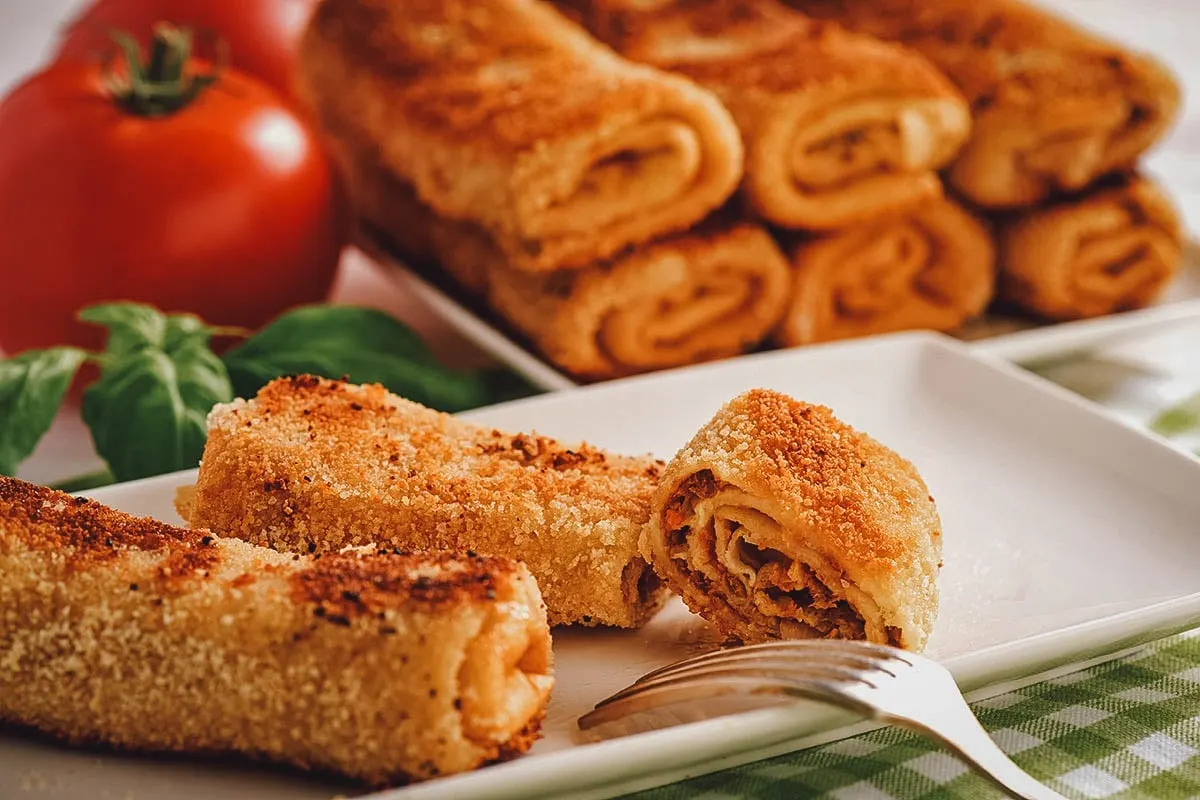
Photo by Cesarz
4. Salatka Jarzynowa
Salatka jarzynowa is the undisputed queen of Christmas in every Polish home. It’s hard not to overdose on it during that annual eating binge that takes place from the 24th of December until New Year’s Eve.
When it comes to ingredients, there seem to be as many recipes for salatka jarzynowa as there are Polish grandmothers. Basically, salatka jarzynowa contains any vegetable of your choice – most commonly boiled potatoes, carrots, pickled cucumbers, celeriac, onion, and parsnip.
But it can’t really be called salatka jarzynowa if it doesn’t have hard-boiled eggs and one magical ingredient (thanks to which everything in life makes more sense) – mayonnaise.
It might be hard to find salatka jarzynowa in a Polish restaurant, but if you get the chance, then you should definitely order it just to know how breakfast, lunch, and dinner tastes during the Christmas season in every Polish home. During this period, it’s an addition to every meal. Seriously.
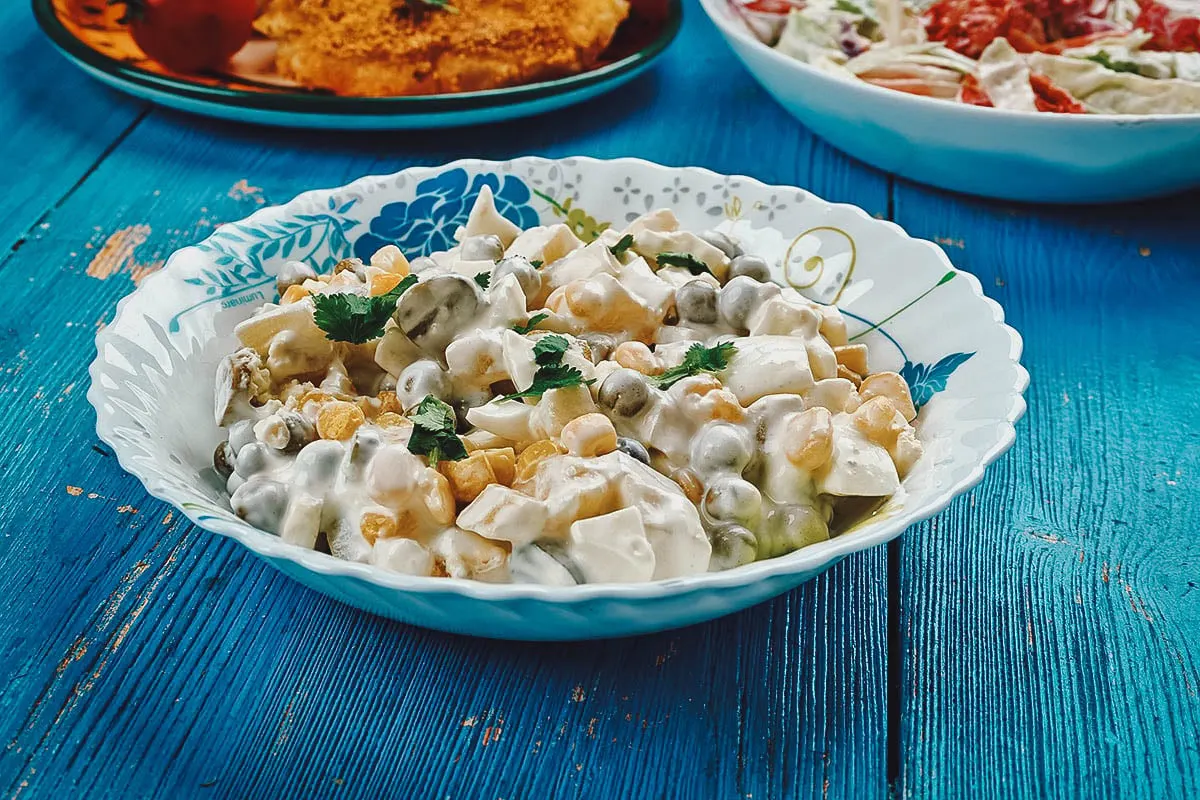
Photo by Fanfo
5. Śledź w Śmietanie
I’m not going to lie. Sledz w smietanie isn’t exactly a Polish dish for beginners. Seeing fish mixed with sour cream will be crossing the line for many. But if you’d like to try more exotic Polish foods and love fish, then it’s definitely worth seeking out.
Herring is one of the most popular types of fish in Poland, and you can probably find it in most Polish homes at any time of the year. Most of the dishes are made with salted filets, meaning that the herring is “cooked” in salt only, by curing in it. After that process, the fish is usually stored in oil.
Herring in sour cream is a common part of the Polish Christmas menu. Sometimes, Poles make it for other special occasions as well, but it’s not an everyday dish. Salted filets are mixed with a sour cream sauce made with chopped onions, apples, salt, pepper, and sugar.
As off-putting as it sounds, sledz w smietanie is a Polish dish that you may fall in love with, if you give it a chance.
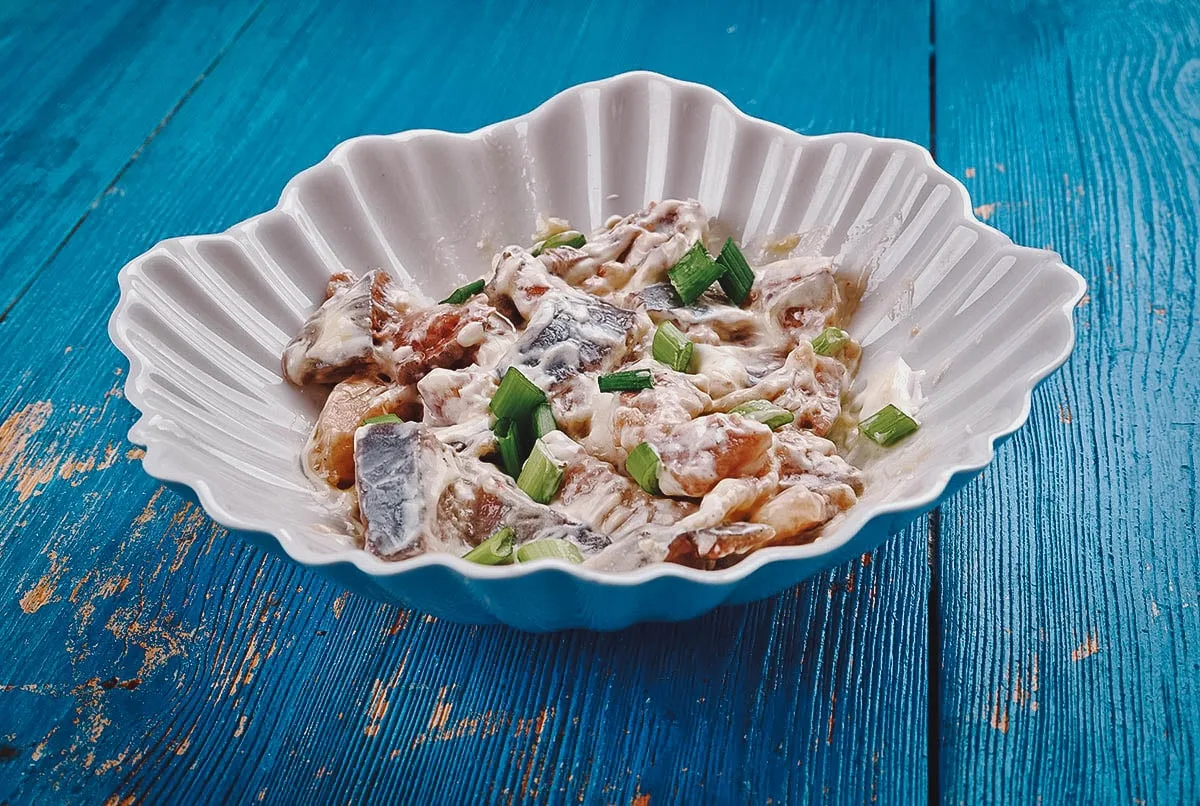
Photo by Fanfo
6. Kopytka
Kopytka for Polish people is like gnocchi for Italians. Like many classic Polish foods, it contains potatoes.
These Polish potato dumplings are traditionally made with mashed potatoes and flour, but you can also find recipes that include eggs. Its name literally means “little hooves”, thanks to their shape which reminds people of an animal’s hooves, like a goat or similar.
Kopytka are especially popular in the south of Poland. They’re super easy to make and supremely tasty. Cooked in salted water, they’re traditionally served alone, but they can be enjoyed with other ingredients as well like sauteed garlic, fried onions, melted butter, mushrooms, or bacon.
Speaking of gnocchi and Italy, why not serve them with parmesan cheese and shaved truffles? Whether traditional or modern, you’ll surely never forget the taste of these delicious Polish dumplings.
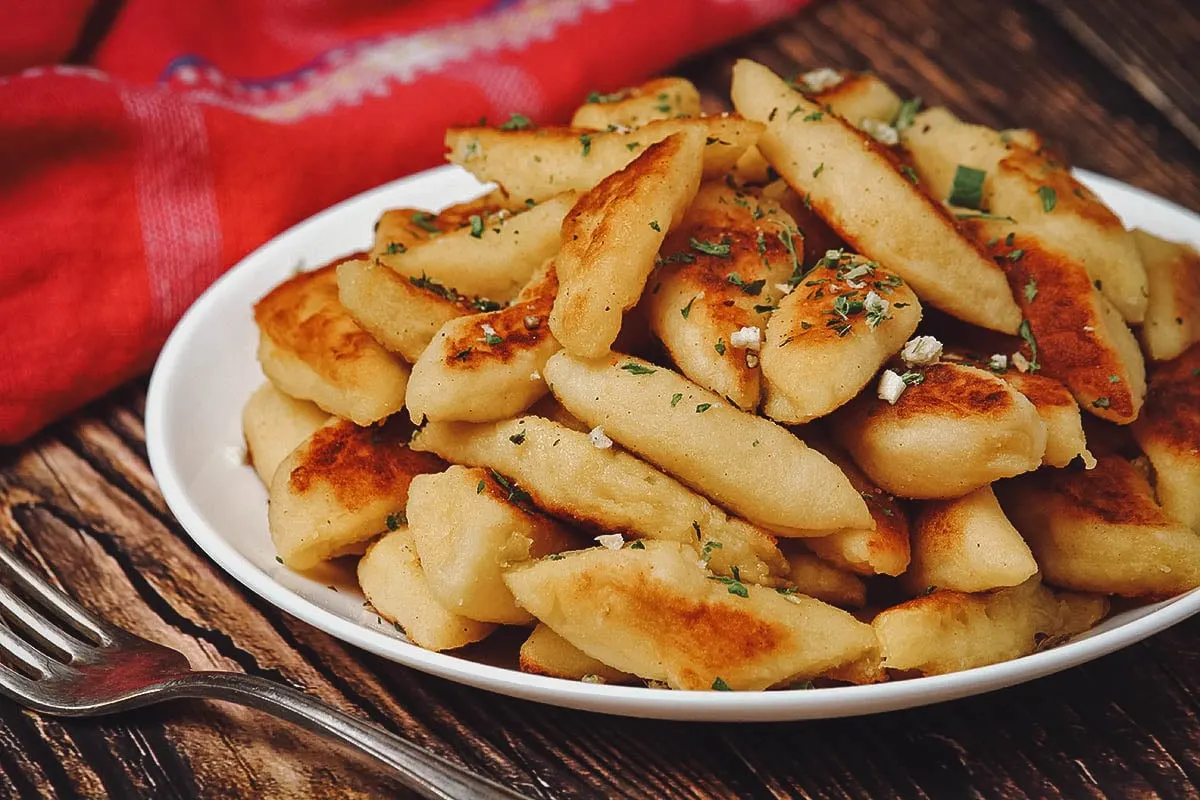
Photo by Anastasia Kamysheva
7. Pierogi
No list of the most popular Polish foods can ever be complete without pierogi. Many European countries like Hungary, Romania, Slovenia, and Ukraine claim ownership of this tasty dish, but when you visit Poland, I strongly advise against claiming pierogi to be anything but Polish dumplings. I’m saying this for your own safety!
Pierogi are often called dumplings in English, but it’s not exactly the same thing. Made with dough and a filling, many different types of pierogi fillings have been used over the years but the classic version consists of a mixture of minced and boiled potatoes, fresh quark, and fried onions.
Christmas Eve is always accompanied by pierogi filled with cabbage and mushroom. Another common version is a sweet type of pierogi filled with blueberries and sugar.
No matter the filling, if you could try just one Polish dish, then it should definitely be pierogi.
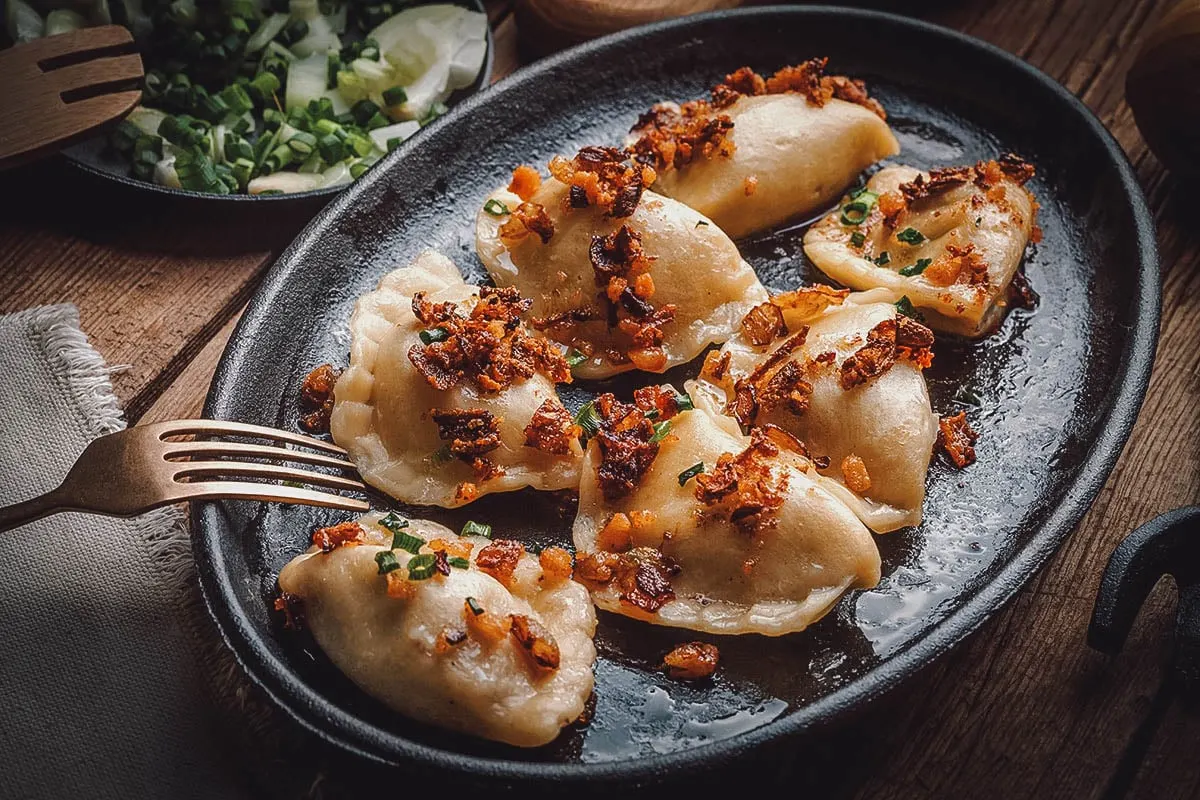
Photo by Arkadiusz Fajer
8. Leniwe Pierogi
Leniwe pierogi is a Polish dish that’s somewhere between a classic pierogi and kopytka. It’s made with flour, eggs, and the third equally important ingredient – quark, which is a type of fermented white cheese. Known as twaróg in Polish, the quark is what differentiates leniwe pierogi from kopytka.
Leniwe pierogi literally means “lazy pierogi”. It’s referred to as “lazy” because unlike classic pierogi where you have to make the dough and filling separately, this lazy version can be made simply by mixing all the ingredients together, cutting them, and then boiling the dumplings in salted water.
You can eat leniwe pierogi with savory or sweet ingredients like sour cream, powdered sugar, brown butter, bacon bits, or roasted pork. Eating lazy pierogi is a great way to spend a slow afternoon in Poland.
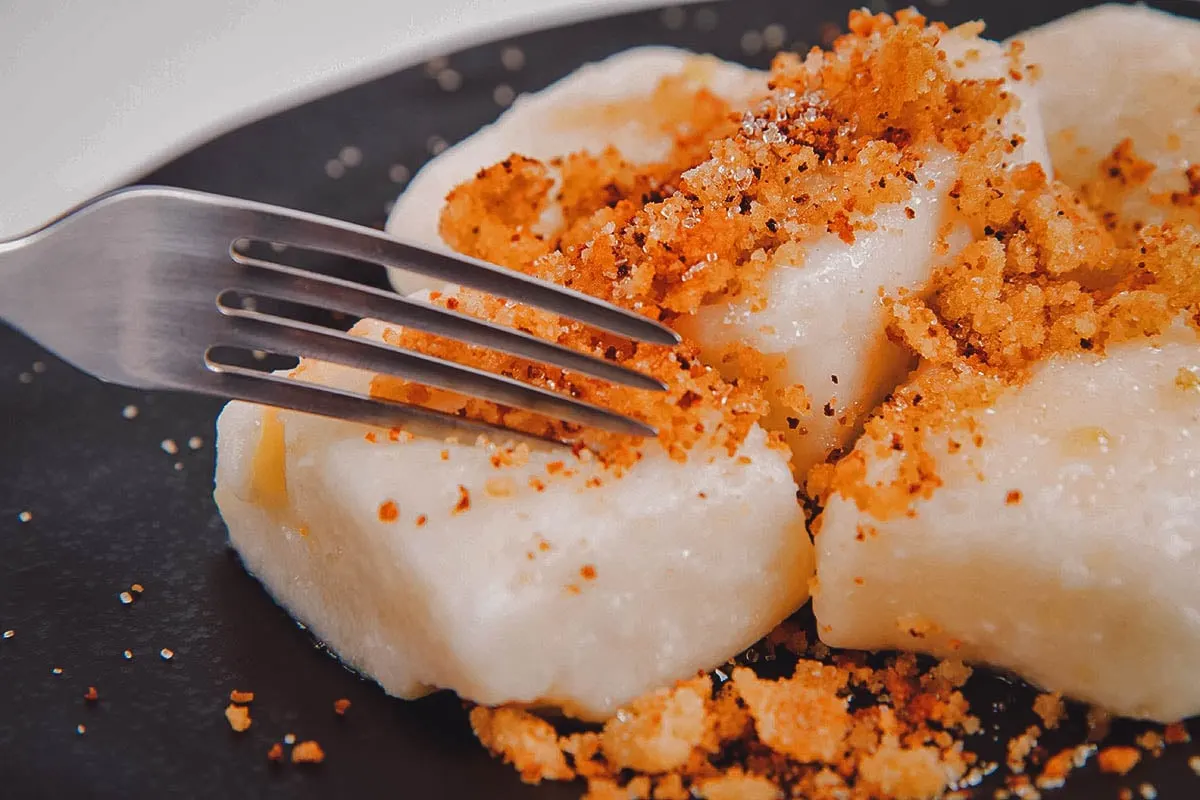
Photo by Aleksandra Duda
SOUPS / STEWS
9. Żurek
This next Polish dish is intense. Get ready for an unforgettable experience, and keep in mind that this sour rye soup is not for everyone. With its intense sour flavor, it has as many fans as it does enemies.
You can try different versions of zurek in western Slavic cuisines, but in Poland, it’s typically made with sour rye flour and meat. At many Polish restaurants, it’s served in an edible bread bowl with boiled eggs and kielbasa (Polish sausage). In Polish homes, zurek is traditionally prepared for Easter but it can occasionally be eaten at other times of the year as well.
The story of how and where this polarizing fermented rye flour soup came into existence remains a mystery.
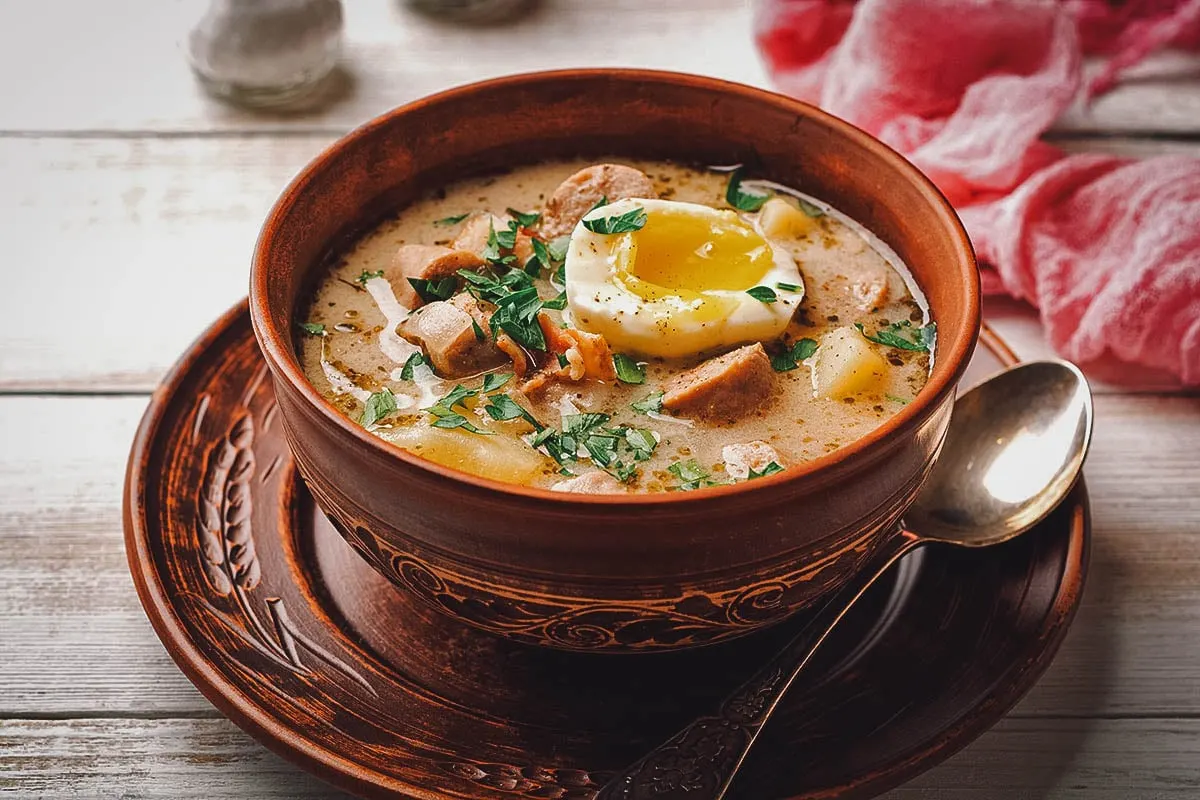
Photo by nesavinov
10. Chłodnik
Chlodnik may not be Polish in origin but that doesn’t keep it from being popular in Poland. In fact, most Polish people refer to it as chłodnik litewski, meaning “Lithuanian cold soup”. You can think of chlodnik as a cold version of the famous borscht (barszcz) because it’s based on beet. But this is where the similarities end.
Chlodnik is made with the leaves and roots of young beets, fermented beet juice, sour cream, kefir, or yogurt. It’s served cold (perfect below 14°C) with chopped radishes, cucumbers, green onions, and hard-boiled egg halves.
Served with boiled potatoes, it’s the perfect dish to enjoy on hot summer days in Poland.
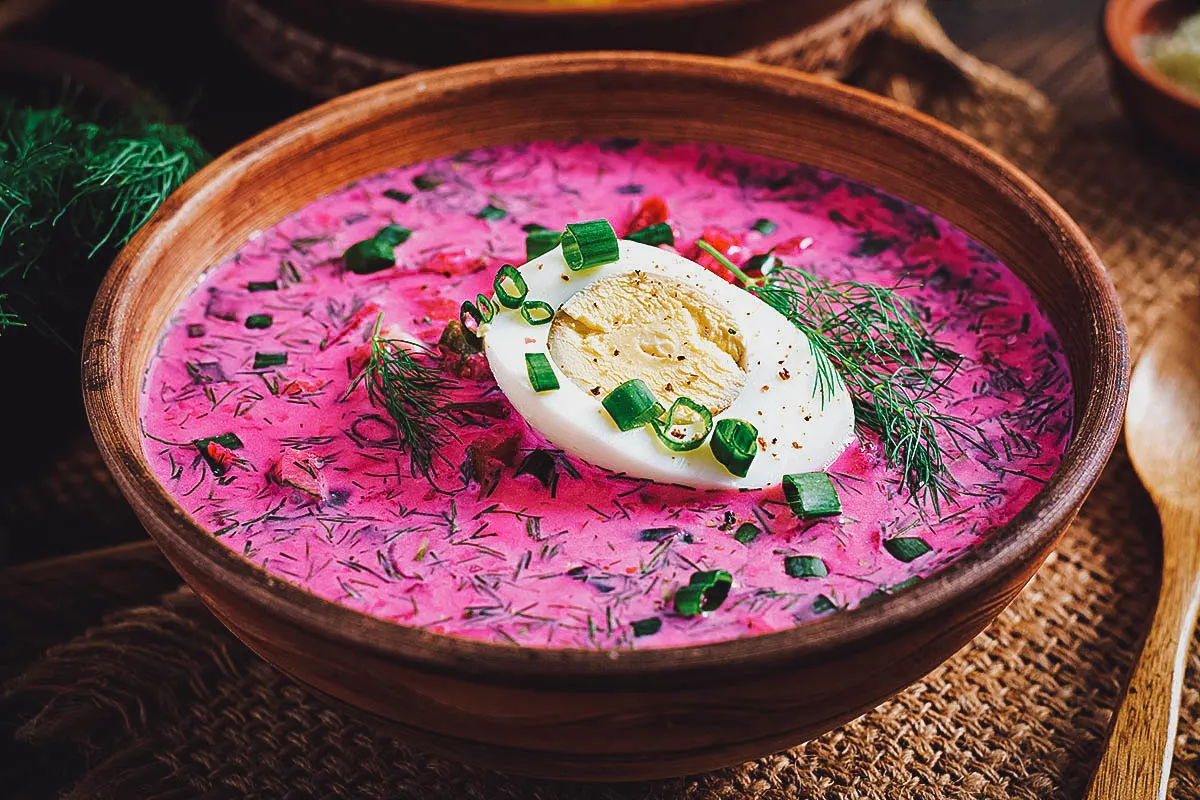
Photo by timolina via Depositphotos
11. Rosół
Rosol is one of the most popular Polish soups. Considered by many to be the best cold or hangover cure, it’s traditionally associated with Sunday family dinners and is present at every wedding.
Rosol is basically a clear chicken soup with a meat and vegetable broth. Recipes vary from household to household, with every grandmother using her own list of ingredients and tricks to make the perfect rosol. The taste of the rosol depends on the types of meat used, the choice of vegetables, and how long you boil it for.
Only one rule can’t be broken – no pork can ever be used in rosol. This is done to ensure that the broth comes out perfectly clear. Patience is also key as you have to boil it slowly for the very same reason.
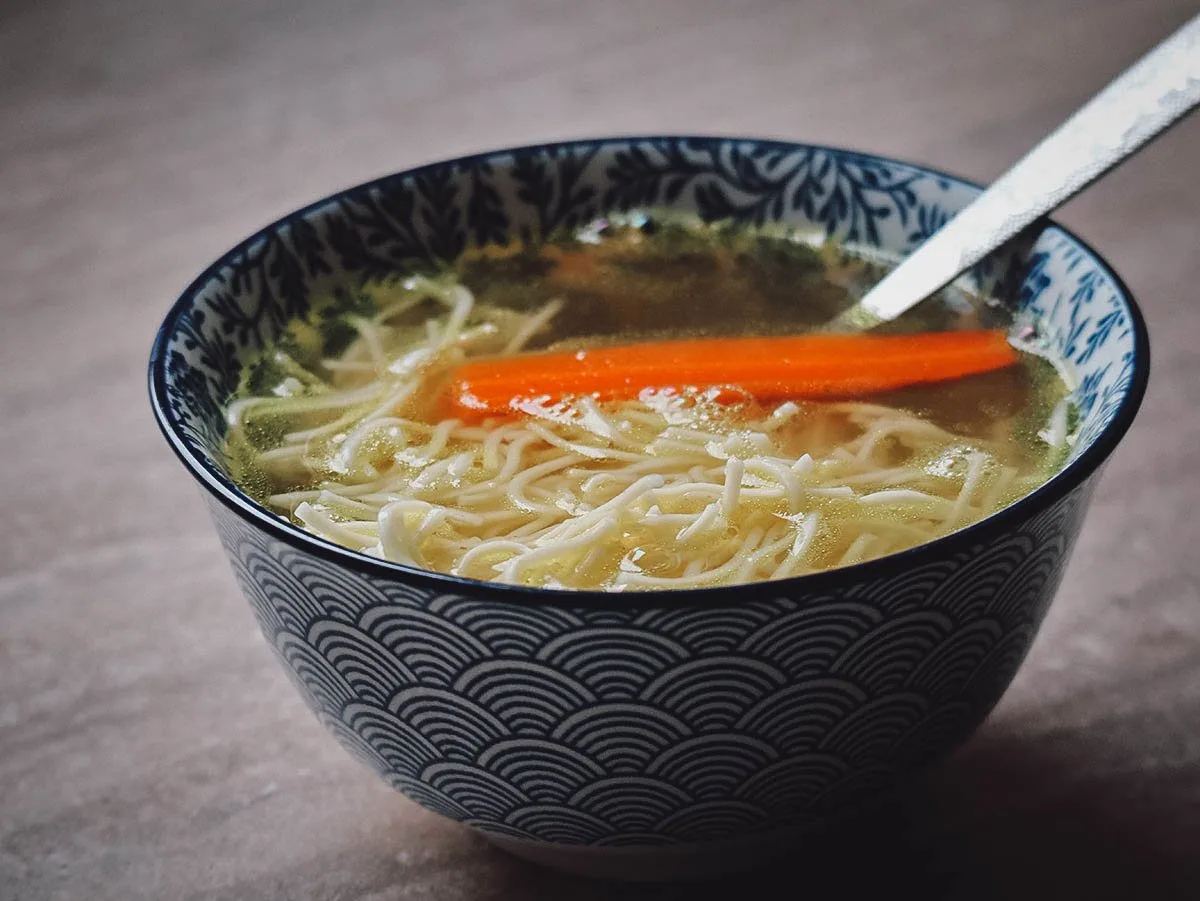
Photo by Przemyslaw Muszynski
12. Flaki
Before anything, let me just say that flaki, in Polish, means “guts”. You have to be an unapologetic meat lover to try this dish. Polish people have been eating animal guts since the 14th century so you can rest assured that we know what we’re doing.
Flaki is one of the most traditional dishes in Polish cuisine. It refers to a type of Polish tripe soup made with thin, well-cleaned strips of beef tripe. You can buy ready-to-eat cans or jars of flaki at grocery stores throughout Poland, or order it at any Polish restaurant.
Flaki is a very thick soup or stew with a strong flavor. If you’re daring enough to stomach animal guts, then you should definitely give this dish a try!
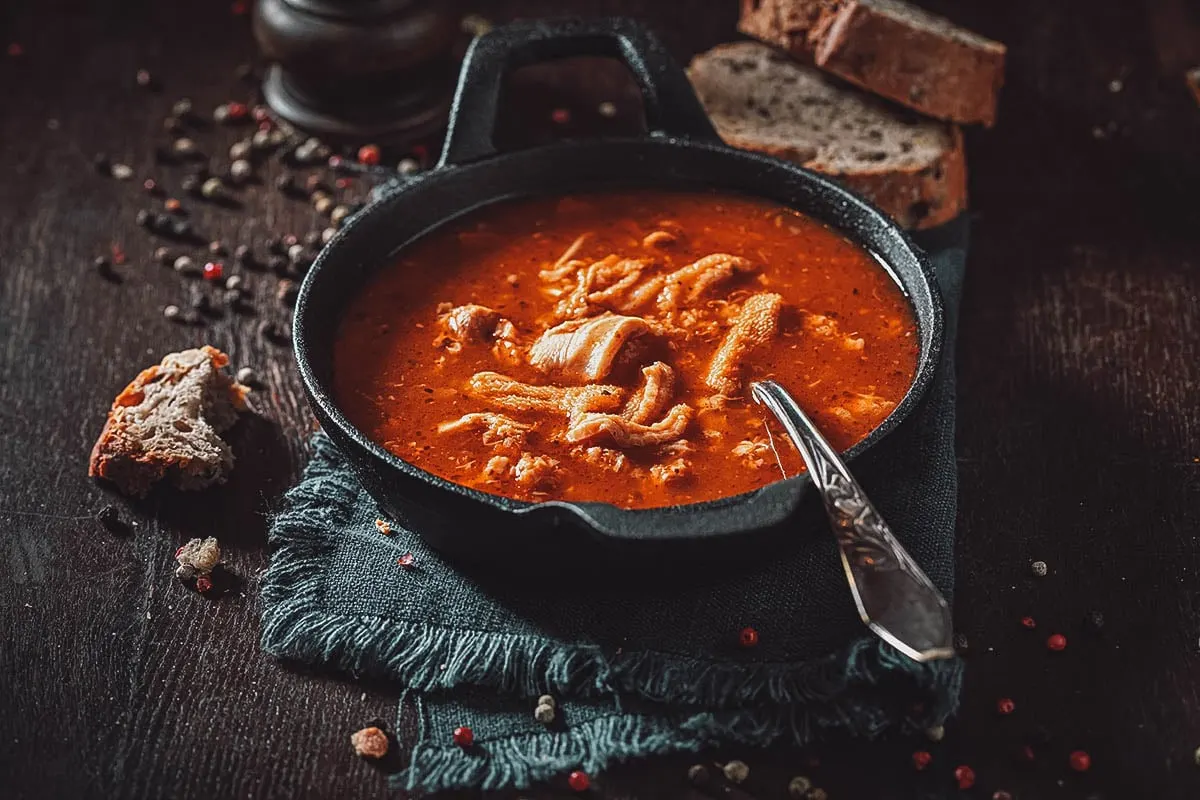
Photo by Shaiith
13. Bigos
Bigos is considered by many to be a Polish national dish. Often referred to as “hunter’s stew”, it gets its nickname from the Polish epic poem “Pan Tadeusz” by Adam Mickiewicz. Originally a humble dish made with whatever ingredients were available, it became a popular dish across all social classes in Poland, ultimately becoming romanticized and immortalized through poetry.
Bigos is made with various kinds of chopped meat mixed with fermented raw cabbage and shredded fresh cabbage. The choice of ingredients makes it a medieval-style Polish dish, meaning it’s highly nutritious and doesn’t spoil easily.
Perfect for long winters, Poles say bigos tastes better with each reheating. It’s delicious but if you have a sensitive stomach, then you may want to go easy on this dish.
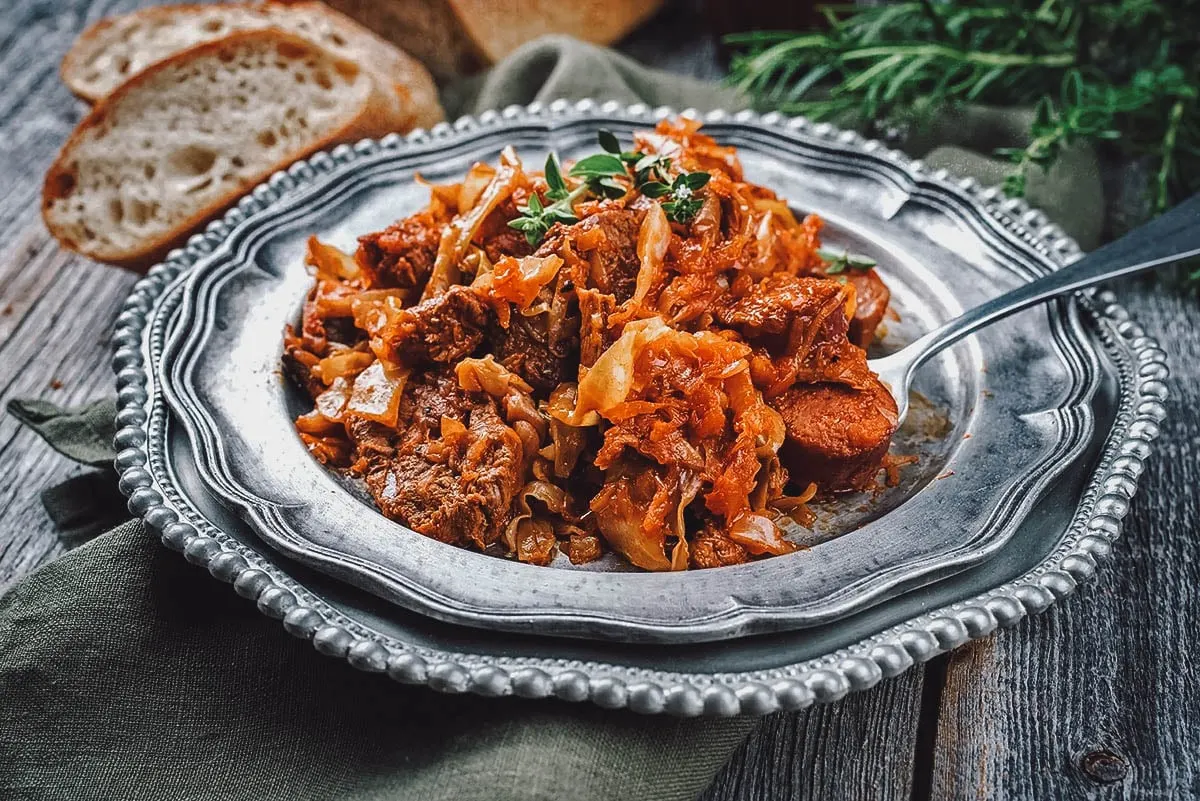
Photo by hlphoto
14. Gulasz
Gulasz is a Hungarian dish that Poles love as their own. You’ll find it throughout the country, sometimes served with potato pancakes (placki ziemniaczane).
Gulasz is a dense soup made with meat and vegetables (like red pepper and onion) flavored with paprika. We called it “soup” but it’s enjoyed more as a main dish – usually on a flat plate – with mashed potato, noodles, or potato pancake.
When eaten with placki ziemniaczane, gulasz is served on top of the potato pancakes. Topped with sour cream, it’s referred to as an “Hungarian-style potato pancake” when prepared in this manner. It’s certainly a tasty way to try two Polish dishes at once!
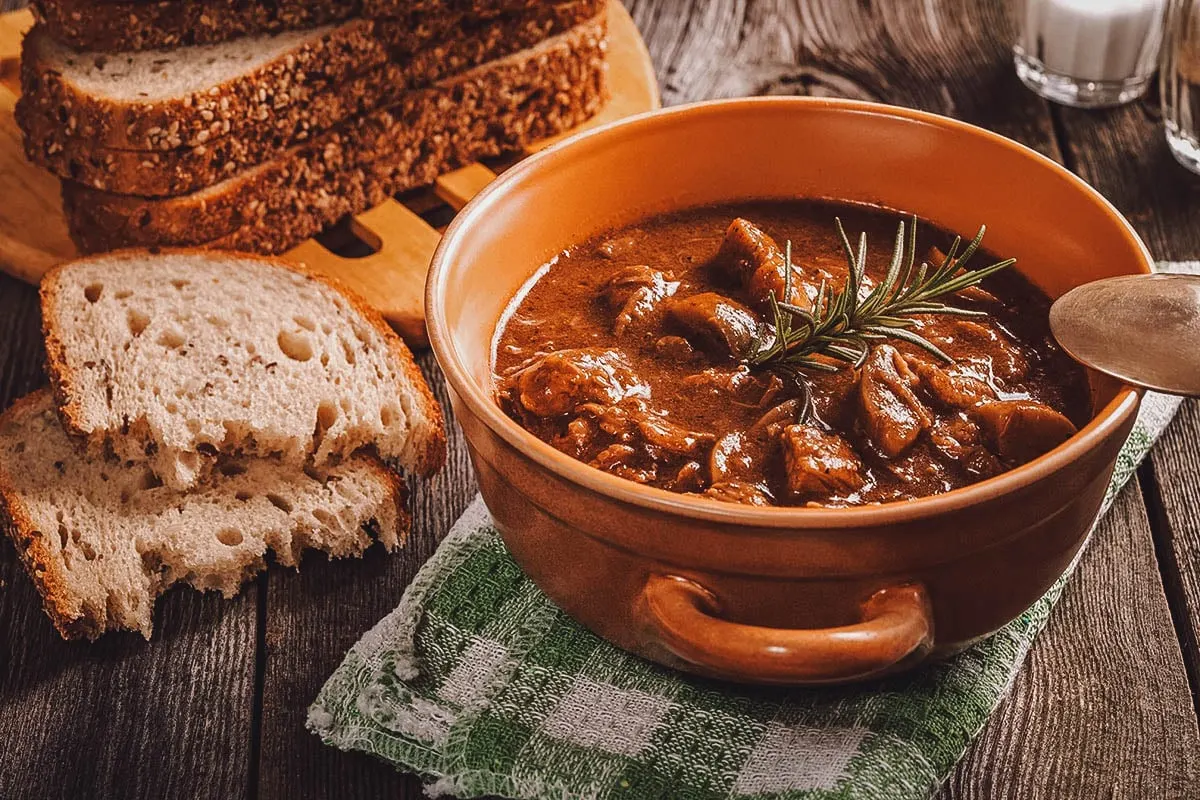
Photo by Arkadiusz Fajer
MEATS / MAINS
15. Golabki
The word golabki literally means “little pigeons” and refers to the Polish version of sarma or stuffed cabbage rolls. They’re popular in many European countries like Albania, Bulgaria, Serbia, and Moldova but Polish people have their own way of making them.
Golabki are made from boiled cabbage leaves wrapped around a filling of minced meat (beef or pork), rice, and onion. You boil the entire cabbage first before peeling off the leaves one by one and then filling them with the minced meat mixture. The cabbage rolls are then topped with hot tomato sauce before serving.
Polish cabbage rolls are typically reserved for special occasions, probably because it’s quite difficult and time-consuming to make. They’re often served as part of a Christmas Eve meal, at weddings, or at other important events.
The etymology of the name suggests that it comes from other languages and originally had nothing to do with pigeons. But the fact that they’re called “little pigeons” probably helps you remember them! It’s a delicious dish that you definitely shouldn’t forget to try in Poland.
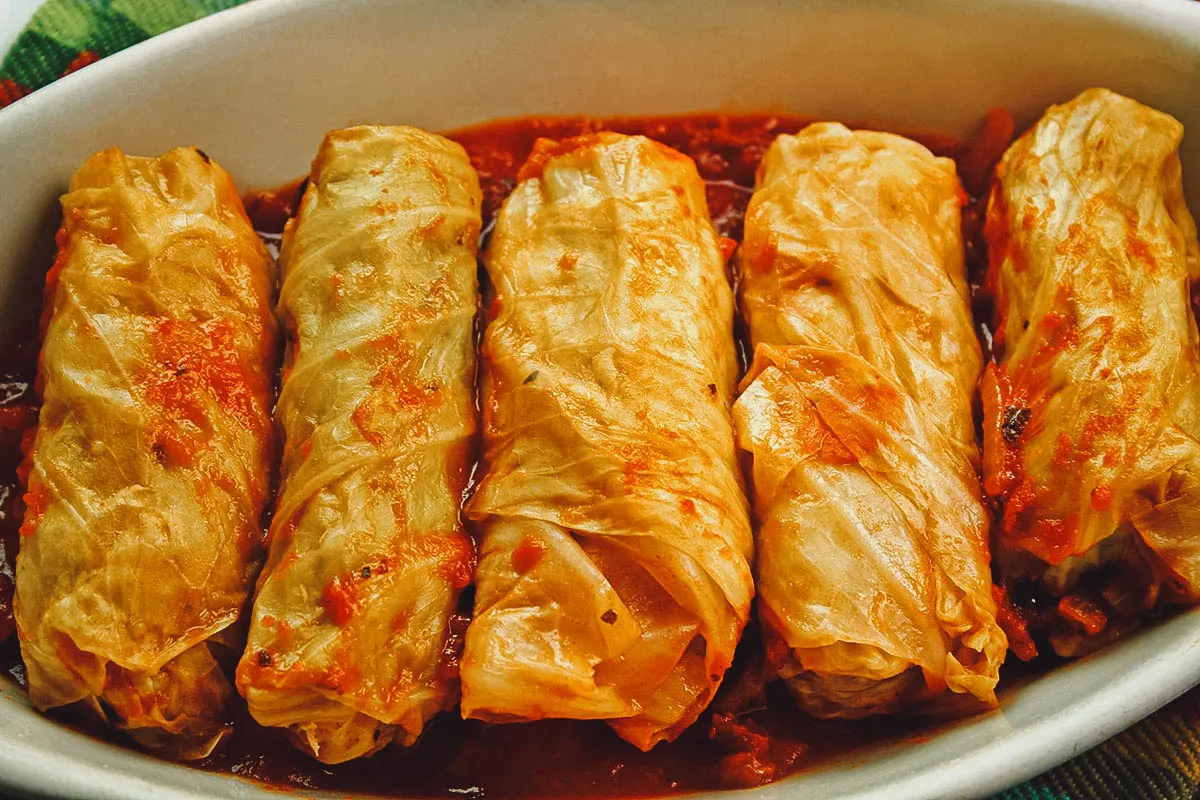
Photo by jabiru via Depositphotos
16. Kotlet Schabowy
Kotlet schabowy is another breaded and fried dish that some Poles are ready to die for. A Polish national dish, if you want to say “Poland” without saying “Poland”, then you can simply say “kotlet schabowy”!
The history of this beloved Polish dish dates back to the 19th century, when it appeared in a cookbook. It’s simply a breaded pork cutlet served with boiled or mashed potatoes and a side of salads. When made properly, it’s impressive to look at due to the cutlet’s large size.
Before frying, the cutlet is pounded until thin with a mallet. The meat is then dipped in flour, then in egg combined with spices, and then lastly in breadcrumbs before being cooked on a frying pan. It’s crispy and very tasty when freshly fried!
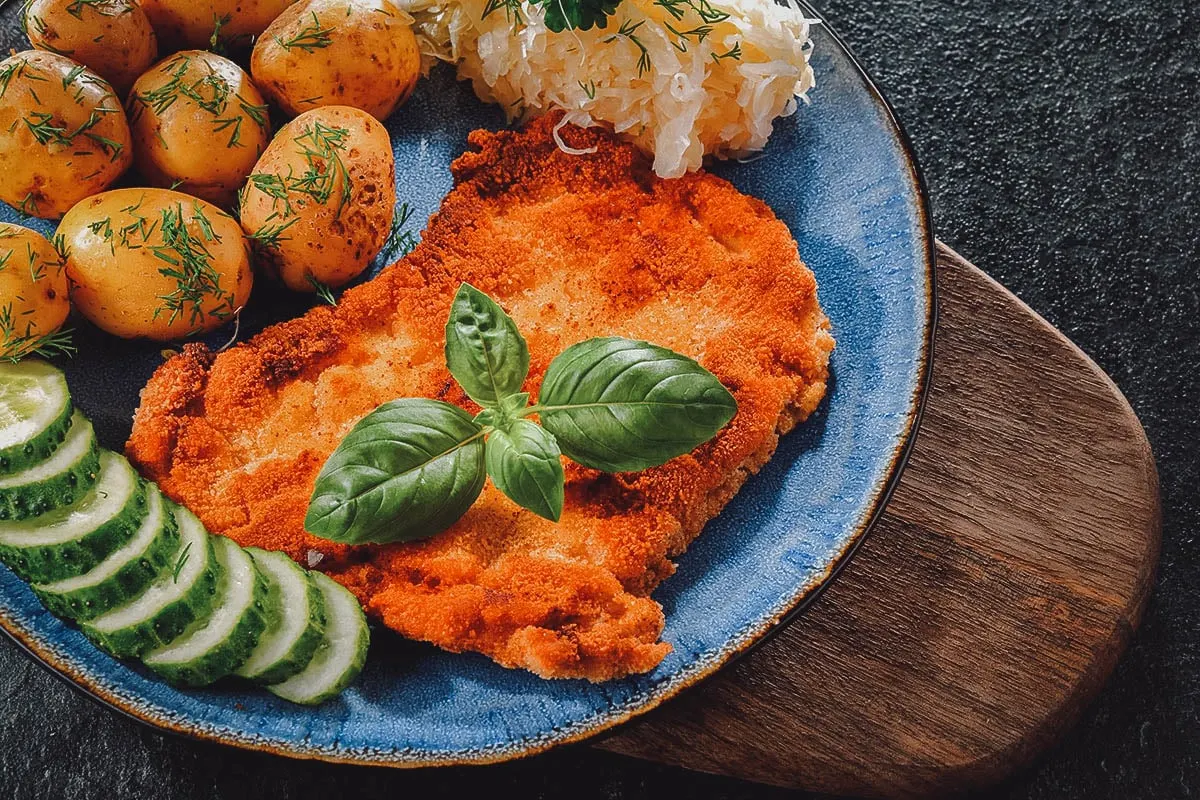
Photo by monticello
17. Ryba po Grecku
Why am I talking about a Greek-style fish dish in an article about Polish food? Because it happens to be one of the most popular dishes in Poland!
Probably inspired by the Greek dish psari plaki, ryba po grecku is made from filets or pieces of fish served in a vegetable sauce made from carrots, celery, onion, parsley, and tomato concentrate. The fish is first fried before being stewed in this sauce.
Ryba po grecku is traditionally served as part of a Christmas Eve meal. It can be served hot or cold, which makes it ready to eat at any moment.
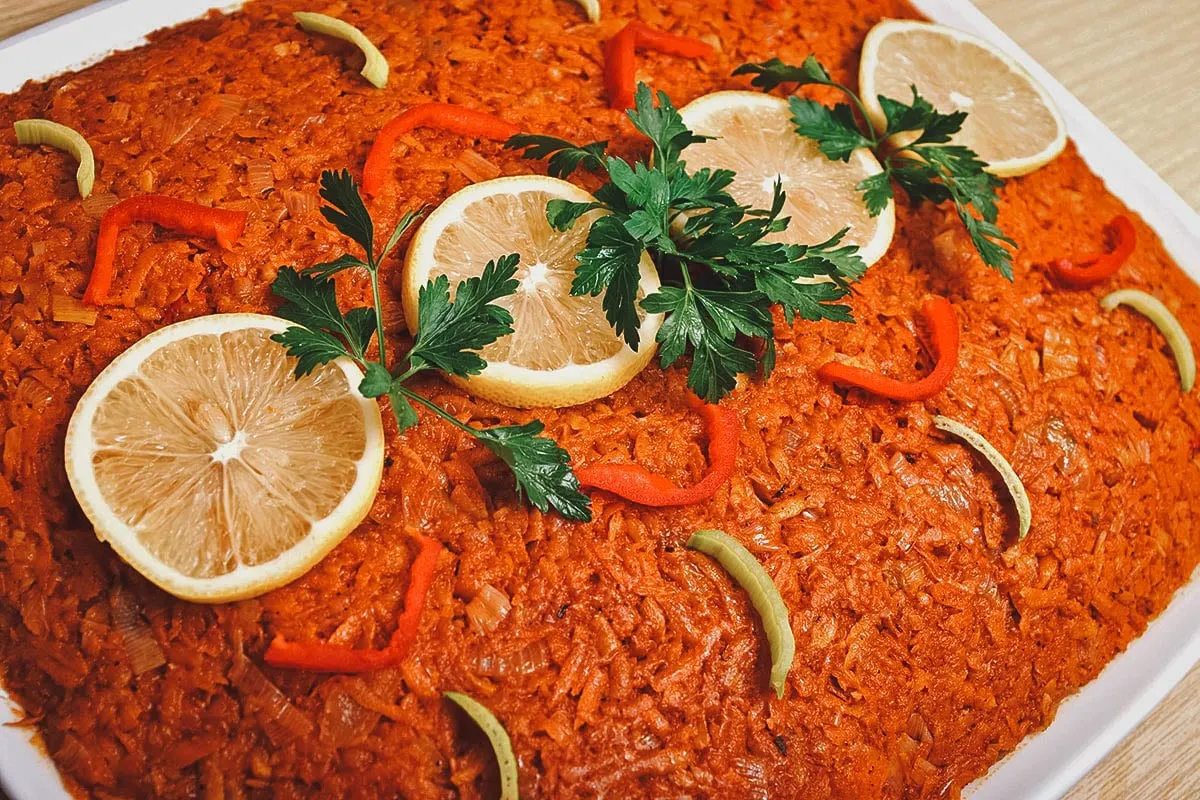
Photo by CCat82
18. Kiełbasa
Kielbasa refers to Polish sausages. There’s no need to explain what a sausage is, but it’s worth mentioning that Poland is famous for many different types of sausage – myśliwska, biała, swojska, śląska, krakowska, podhalańska, kaszanka, etc. Believe it or not, I can go on forever!
Most of the time, Polish sausages are made with pork, and the more meat it has in the mixture, the better. Making it with too much potato flour, water, or other non-meat ingredients is seen as lowering the product’s quality. The sausages are then traditionally preserved by smoking rather than drying, due to Poland’s climate conditions.
Polish sausages are typically eaten on bread or as an appetizer, but during the summer season, they’re commonly grilled or cooked over an open fire.
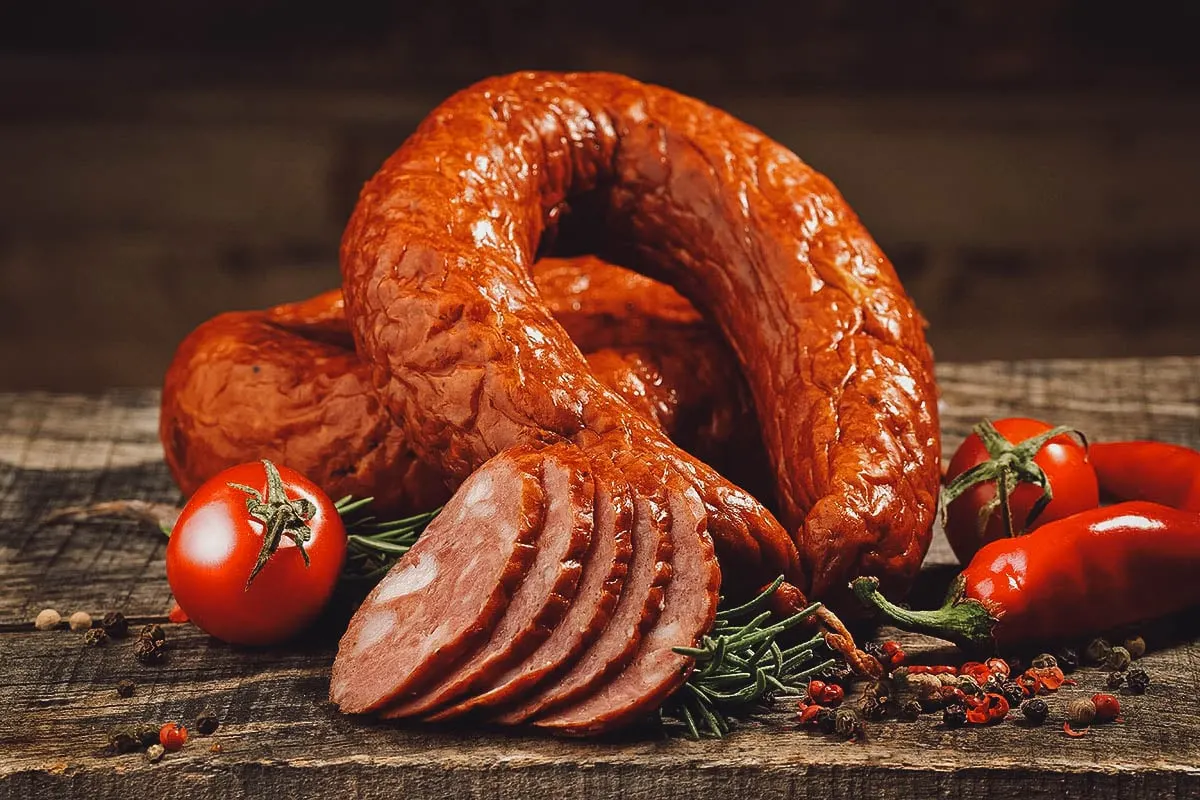
Photo by Gravika
19. Kabanosy
Kabanosy is a type of Polish sausage that’s become so popular that it deserves its own entry in this Polish food guide. It refers to a long and thin dry sausage made from pork that’s typically eaten as an appetizer or a snack. A bit smoky in flavor, it can be soft on the inside or really dry, depending on the type and freshness.
Since 2011, kabanos has been registered as a Traditional Speciality Guaranteed food product by the European Union, which helps consumers know that the sausage they’re buying is authentic and of Polish origin.

Photo by JacZia
DESSERTS
20. Naleśniki
You can’t skip this classic when talking about Polish cuisine. Naleśniki refer to crepe-style Polish pancakes.
Pancakes in Poland are thin and resemble French crepes. Flat and round, they’re prepared from a batter made from eggs, milk, and wheat flour, which is then cooked on a frying pan.
The most traditional version is sweet, filled with white cheese mixed with sugar. In some Polish homes, a bit of cinnamon can be added. Today, however, you can find naleśniki made with many different types of sweet and savory fillings.
One Polish pancake that you should definitely try is racuchy. They’re similar to North American pancakes except they’re smaller and thicker and filled with slices of apple (sometimes flavored with cinnamon). A favorite among Polish children, you can read more about them in our guide to the tastiest Polish desserts.

Photo by Robson90
21. Pączki
Do you know what my favorite thing is about Polish doughnuts? They don’t have a hole.
Unlike your typical North American doughnut, Polish paczki are filled with a variety of delicious ingredients like wild rose petal jam, multi-fruit marmalade, pudding, chocolate, sweet cheese, and egg liqueur. Soft and fluffy, they’re typically topped with a glaze or powdered sugar.
Paczki are so beloved in Poland that on Fat Thursday (the last Thursday prior to Ash Wednesday), many Polish people eat them without stopping – and then discuss who ate the most. They’ve been a favorite in Poland since at least the Middle Ages. Fat chance they’ll ever be forgotten!

Photo by tupungato
22. Makowiec
Makowiec refers to a magical Polish cake that harkens back to pagan traditions, when poppy seeds consumed on the night of the winter solstice were supposed to bring good luck and protect against evil forces. Like honey and mushrooms, poppy seeds were considered a link with the beyond.
Makowiec is a cake layered with ground poppy seeds, sugar/honey, nuts, and raisins. It’s traditionally reserved for Christmas Eve and can take different forms, depending on where it was made in Poland.
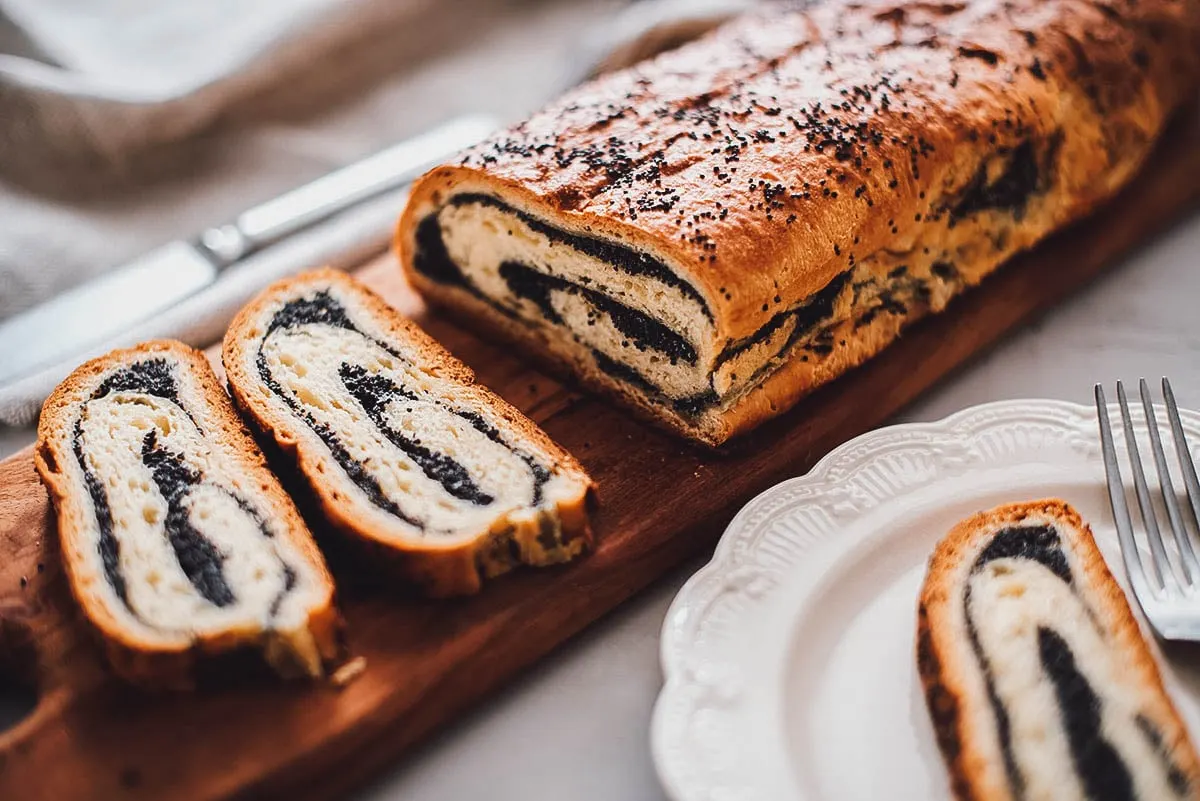
Photo by Letterberry
23. Piernik
Piernik is popular in many Slavic countries. It’s traditionally made from wheat flour and honey, and also ginger which was used as an optional ingredient.
Today, this gingerbread treat can be made in various forms – from small stuffed cookies to cakes layered with marmalade. No matter the form, they don’t lose their basic characteristics – durability and a unique flavor imparted by spices like ginger, nutmeg, and cardamom.
In Poland, Toruń is a city famous for its gingerbread. Toruńskie pierniki has been made there for over 700 years. Piernik is enjoyed in many other regions of Poland as well, but mainly during the Christmas season.
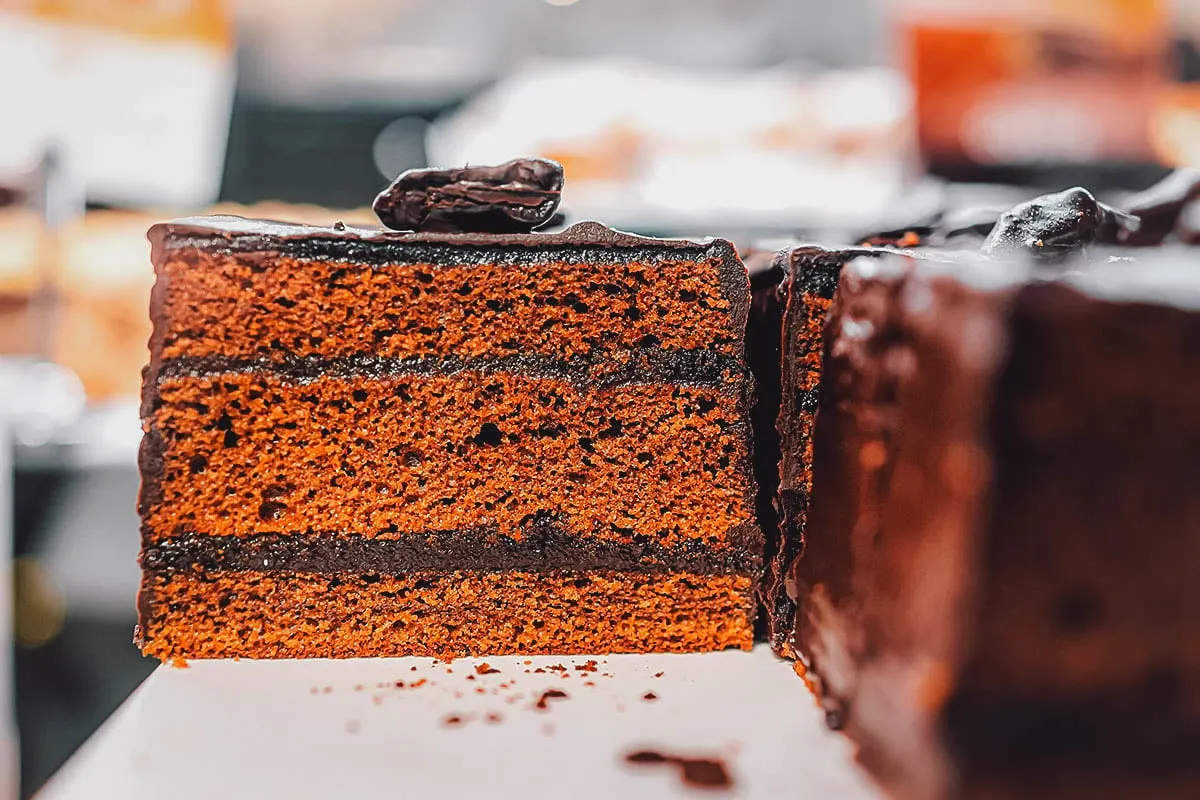
Photo by Kristi Blokhin
24. Sernik
This next dessert doesn’t really have its roots in Poland, but we Poles really know how to make it right!
The varieties of sernik are endless, but what makes it truly special is the cheese. Polish white cheese (biały ser) or quark (twaróg) is unlike any other, so much so that it’s perhaps the secret ingredient in many delicious Polish dishes like pierogi. Since cheese is the main ingredient in cheesecake, I can confidently say that Polish sernik is the world’s best.
Polish people can all agree that our version of cheesecake is the best, but there’s a never-ending debate as to whether Polish sernik should be made with or without raisins.

Photo by Karjalas
25. Szarlotka
Last but not least, we get to this world-renowned classic – apple pie. Known as szarlotka, this delicious Polish version is made with shortcrust pastry and juicy Polish apples (or optionally other fruits) covered in a crumbly topping. When served hot and with a scoop of vanilla ice cream, few things in life are better than szarlotka.
Szarlotka isn’t to be confused with jabłecznik or Polish apple cake. Unlike szarlotka that’s made with shortcrust pastry, jabłecznik can be made with any type of base – puff pastry, sponge cake, etc.
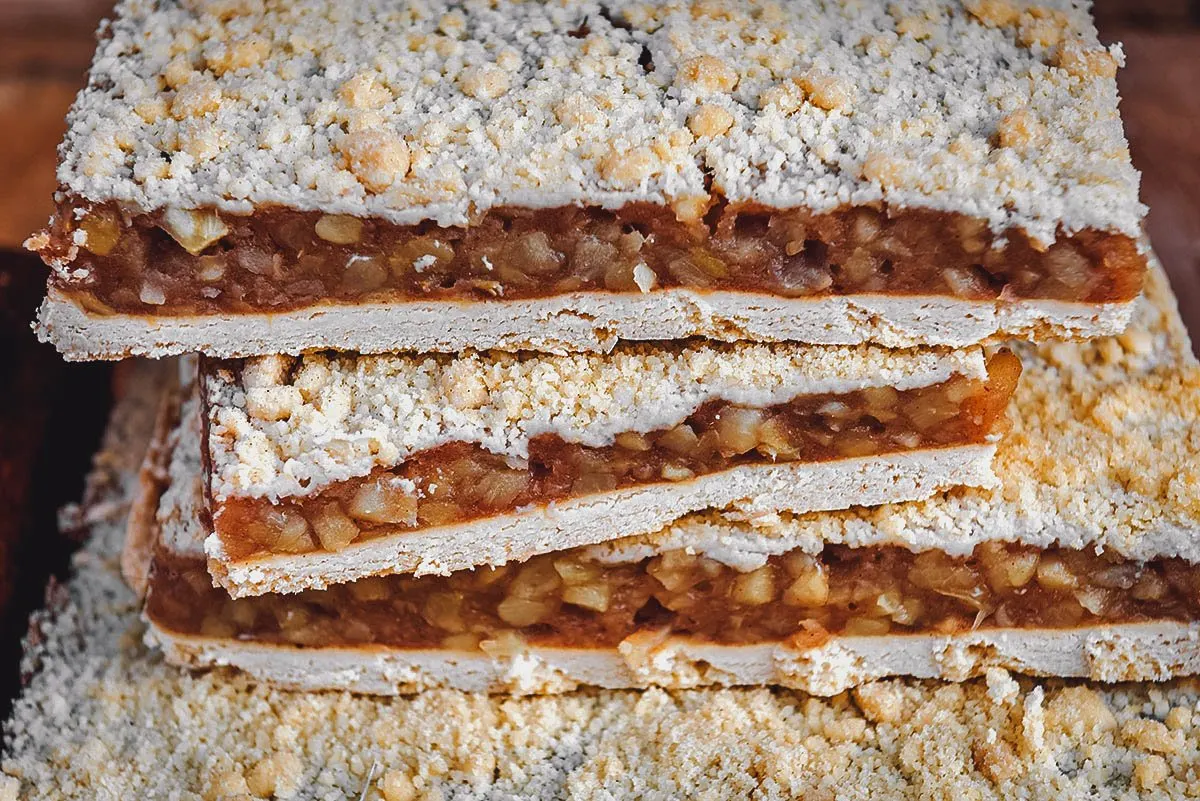
Photo by Fotokon
FINAL THOUGHTS ON TRADITIONAL POLISH FOOD
Many Polish dishes will surprise your taste buds and linger in your memory.
Some flavors will make you want to come back. Others you’ll prefer to forget. But one thing is for sure – you will never say that Polish cuisine is not expressive.
This beautiful country has so much to offer and experience. We’re sure that eating local Polish food will enrich your trip and make it a story worth remembering, and telling.
Disclosure
This article on traditional Polish food contains affiliate links. If you make a purchase, then we’ll earn a small commission at no additional expense to you. As always, we only recommend products and services that we use ourselves and firmly believe in. We really appreciate your support as this helps us make more of these free travel and food guides. Thank you!
Cover photo by Arkadiusz Fajer. Stock images via Shutterstock.


David Wilson
Wednesday 15th of February 2023
Were can I buy AUTHENTIC (made in Poland) food. Thanks Dave